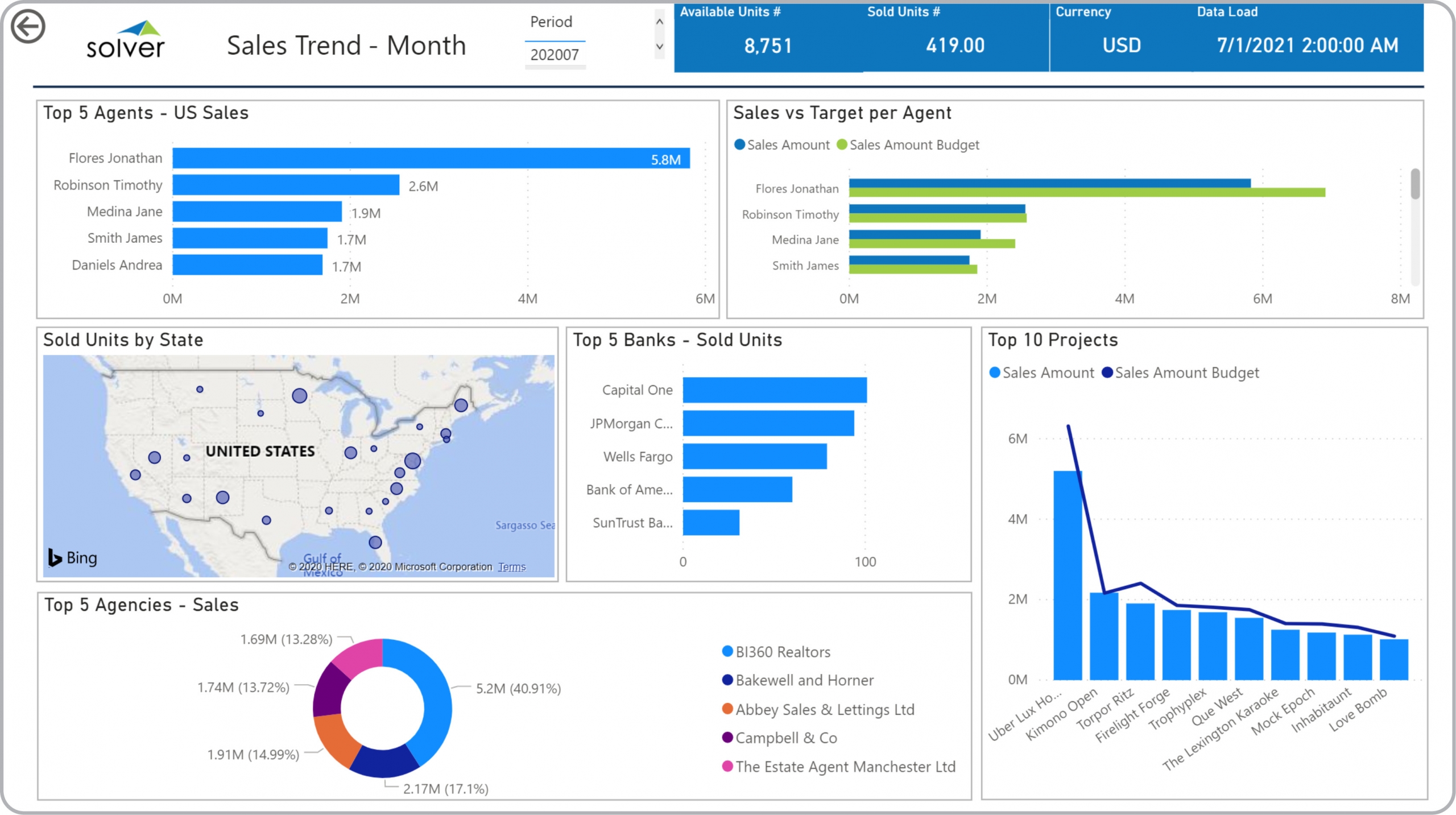Monthly Sales Dashboard for Real Estate Companies
What is a
Monthly Sales Dashboard
? Monthly sales dashboards are considered important month end performance tools and are used by executives and sales leaders to slice and dice monthly sales data. Some of the main functionality in this type of dashboard is that it enables easy sales monitoring using six charts as well as with KPIs. The user selects the month from the drop down box at the top of the dashboard and this will display all the charts and metrics based on the chosen period. The analysis includes: 1) Sales for the top 5 agents, 2) Actual versus budgeted sales per agent, 3) Sold units by state, 4) Top 5 banks - sold units, 5) Top 10 projects, and 6) Top 5 agencies. The KPI section on the top of the screen shows Total available units and Total sold units. You find an example of this type of dashboard below.
Purpose of
Monthly Sales Dashboards
for Real Estate Businesses Real Estate companies use Monthly Sales Dashboards to provide managers with an easy way to monitor monthly sales performance. When used as part of good business practices in Financial Planning & Analysis (FP&A) and sales departments, an organization can improve its revenues and sales strategies, and it can reduce the chances that monthly outliers are not detected quickly so they can be analyzed.
Example of a
Monthly Sales Dashboard Here is an example of a Monthly Real Estate Sales Dashboard with ranking of agents, agencies, banks and projects. [caption id="" align="alignnone" width="2560"]
 Example of a Monthly Sales Dashboard for Real Estate Companies[/caption] You can find hundreds of additional examples
here
Who Uses This Type of
Dashboard
? The typical users of this type of dashboard are: Executives, CFOs, analysts.
Other Reports Often Used in Conjunction with
Monthly Sales Dashboards Progressive Financial Planning & Analysis (FP&A) departments sometimes use several different Monthly Sales Dashboards, along with financial dashboards, consolidated and local office profit & loss reports, sales reports, sales forecast, annual budgets, project reports and other management and control tools.
Where Does the Data for Analysis Originate From? The Actual (historical transactions) data typically comes from enterprise resource planning (ERP) systems like: Microsoft Dynamics 365 (D365) Finance, Microsoft Dynamics 365 Business Central (D365 BC), Microsoft Dynamics AX, Microsoft Dynamics NAV, Microsoft Dynamics GP, Microsoft Dynamics SL, Sage Intacct, Sage 100, Sage 300, Sage 500, Sage X3, SAP Business One, SAP ByDesign, Acumatica, Netsuite and others. In analyses where budgets or forecasts are used, the planning data most often originates from in-house Excel spreadsheet models or from professional corporate performance management (CPM/EPM) solutions.
What Tools are Typically used for Reporting, Planning and Dashboards? Examples of business software used with the data and ERPs mentioned above are:
Example of a Monthly Sales Dashboard for Real Estate Companies[/caption] You can find hundreds of additional examples
here
Who Uses This Type of
Dashboard
? The typical users of this type of dashboard are: Executives, CFOs, analysts.
Other Reports Often Used in Conjunction with
Monthly Sales Dashboards Progressive Financial Planning & Analysis (FP&A) departments sometimes use several different Monthly Sales Dashboards, along with financial dashboards, consolidated and local office profit & loss reports, sales reports, sales forecast, annual budgets, project reports and other management and control tools.
Where Does the Data for Analysis Originate From? The Actual (historical transactions) data typically comes from enterprise resource planning (ERP) systems like: Microsoft Dynamics 365 (D365) Finance, Microsoft Dynamics 365 Business Central (D365 BC), Microsoft Dynamics AX, Microsoft Dynamics NAV, Microsoft Dynamics GP, Microsoft Dynamics SL, Sage Intacct, Sage 100, Sage 300, Sage 500, Sage X3, SAP Business One, SAP ByDesign, Acumatica, Netsuite and others. In analyses where budgets or forecasts are used, the planning data most often originates from in-house Excel spreadsheet models or from professional corporate performance management (CPM/EPM) solutions.
What Tools are Typically used for Reporting, Planning and Dashboards? Examples of business software used with the data and ERPs mentioned above are:
- Native ERP report writers and query tools
- Spreadsheets (for example Microsoft Excel)
- Corporate Performance Management (CPM) tools (for example Solver)
- Dashboards (for example Microsoft Power BI and Tableau)
Corporate Performance Management (CPM) Cloud Solutions and More Examples
March 27, 2021
TAGS:
Reporting,
Solver,
report writer,
Microsoft,
template,
practice,
Acumatica,
agency,
visualization,
Netsuite,
Finance,
planning,
GP,
dashboard,
realtor agent,
Business Central,
excel,
ax,
realtor,
forecast,
Budget,
month,
Dynamics 365,
realty,
budgeting,
Cloud,
Software,
Tableau,
SAP,
example,
best,
Sage,
BC,
D365,
agent,
NAV,
Intacct,
Real Estate,
project,
CPM,
report,
SL,
Management,
dynamics,
sales,
Power BI,
real estate dashboard

